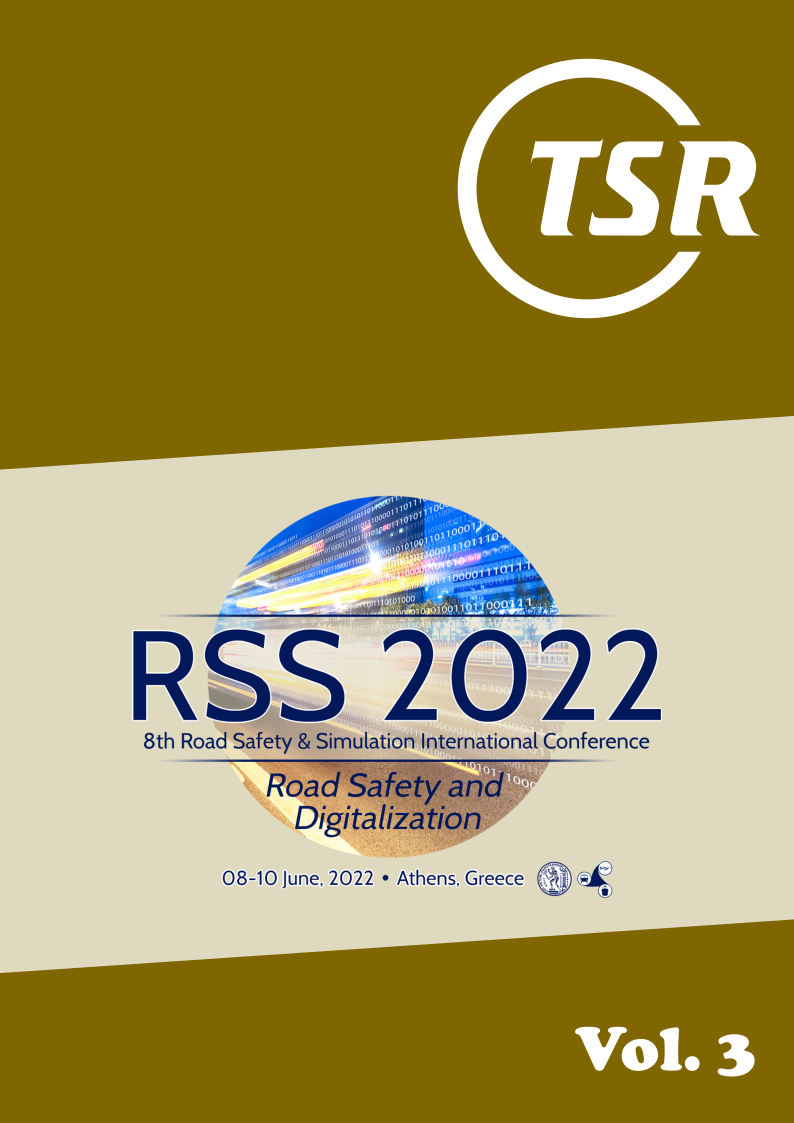Safety evaluation of urban roundabouts in India: a safety performance function-based approach
DOI:
https://doi.org/10.55329/bylj4120Keywords:
negative binomial, roundabouts, safety performance function, weaving lengthAbstract
There is a lack of comprehensive research in roundabout safety under non-lane-based traffic conditions, mainly due to the absence of relevant crash data and effective tools for safety evaluation. Safety Performance Function (SPF) is a suitable tool for providing valuable information related to factors which can potentially contribute to the likelihood of increasing traffic crashes. Currently, very limited studies are available to explain the usefulness of SPF in the vicinity of roundabouts, especially at non-lane-based traffic conditions. This study aims to develop an SPF model for assessing the safety evaluation at roundabouts as a whole (intersection level) and the approach level. Data corresponding to crashes in nineteen roundabouts with different geometric and traffic characteristics was used for model formulation. Crash data for five years (2015–2019) was obtained from the State Crime Records Bureau. An SPF model was developed using a negative binomial model with a log-link function based on the number of crashes, traffic characteristics, and geometry characteristics of the roundabouts. The proportion of powered two-wheelers, percentage of heavy vehicles, entry-angle, and weaving-length were all significantly related with higher crash occurrences at roundabouts, according to the findings. In contrast, the number of circulatory lanes, inscribed circle diameter, and presence of road lane marking were negatively associated with the increased crash occurrences at the roundabout vicinity. In addition to this, the overall crash rate significantly varies across roundabout sections due to the asymmetric effects of geometric and traffic characteristics. The developed SPF would best explain the relationship between geometric and traffic characteristics and the crash occurrence rate in non-lane traffic conditions. The findings of this study support the need to relook at design parameters for better movement at the roundabouts, thereby improving the existing facilities to enhance road users' safety, especially in developing countries. The proposed SPF tool would help engineers examine the safety of roundabouts in terms of design adequacy, quantifying the risk factors, and future crash predictions.
Downloads
References
Abdul Manan, M. M., T. Jonsson, A. Várhelyi (2013), ‘Development of a safety performance function for motorcycle accident fatalities on Malaysian primary roads’, Safety Science, 60, 13–20, https://doi.org/10.1016/j.ssci.2013.06.005. DOI: https://doi.org/10.1016/j.ssci.2013.06.005
Abhigna, D., S. Kondreddy, K. V. R. R. Shankar (2016), ‘Effect of vehicle composition and delay on roundabout capacity under mixed traffic conditions’, Archives of Transport, 40 (4), 7–14, https://doi.org/10.5604/08669546.1225456. DOI: https://doi.org/10.5604/08669546.1225456
Akaike, H. (1974), ‘A new look at the statistical model identification’, IEEE Transactions on Automatic Control 19 (6), 716–723, https://10.1109/TAC.1974.1100705. DOI: https://doi.org/10.1109/TAC.1974.1100705
Al-Marafi, M. N., K. Somasundaraswaran, R. Ayers (2020), ‘Developing crash modification factors for roundabouts using a cross-sectional method’, Journal of Traffic and Transportation Engineering (English Edition), 7 (3), 362–374, https://doi.org/10.1016/j.jtte.2018.10.012. DOI: https://doi.org/10.1016/j.jtte.2018.10.012
Anjana, S., M. V. L. R. Anjaneyulu (2015), ‘Development of Safety Performance Measures for Urban Roundabouts in India’, Journal of Transportation Engineering, 141 (1), https://doi.org/10.1061/(ASCE)TE.1943-5436.0000729. DOI: https://doi.org/10.1061/(ASCE)TE.1943-5436.0000729
Arndt, O. K., R. J. Troutbeck (1998), ‘Relationship between Roundabout Geometry and Accident Rates’, presented at International Symposium on Highway Geometric Design Practices (Boston, MA, USA: 30 August–1 September 1995).
Avidemux (n/d), ‘Avidemux: Free video editor’, https://avidemux.sourceforge.net/, accessed 4 October 2022.
Bared, J. G., W. Prosser, C. Tan Esse (1997), ‘State-of-the-Art Design of Roundabouts’, Transportation Research Record: Journal of the Transportation Research Board, 1579 (1), https://doi.org/10.3141/1579-01. DOI: https://doi.org/10.3141/1579-01
Bauer, K. M., D. W. Harwood (2000), ‘Statistical Models of At-Grade Intersection Accidents’ (McLean, VA, USA: Federal Highway Administration), FHWA-RD-99-094, https://www.fhwa.dot.gov/publications/research/safety/99094/99094.pdf, accessed 4 October 2022.
Cafiso, S., A. Di Graziano, G. Di Silvestro, et al. (2010), ‘Development of comprehensive accident models for two-lane rural highways using exposure, geometry, consistency and context variables’, Accident Analysis & Prevention, 42 (4), 1072–1079, https://doi.org/10.1016/j.aap.2009.12.015. DOI: https://doi.org/10.1016/j.aap.2009.12.015
Charly, A., T. V. Matthew (2019), ‘Estimation of traffic conflicts using precise lateral position and width of vehicles for safety assessment’, Accident Analysis & Prevention, 132, 105264, https://doi.org/10.1016/j.aap.2019.105264. DOI: https://doi.org/10.1016/j.aap.2019.105264
Dixon, K., J. Zheng (2013), ‘Developing safety performance measures for roundabout applications in the state of Oregon’ (Oregon Department of Transportation and Federal Highway Administration), FWHA-OR-RD-13-08, https://www.oregon.gov/odot/Programs/ResearchDocuments/SPR733_Roundabout.pdf, accessed 4 October 2022.
Ferguson, E., J. Bonneson, L. Rodegerdts, et al. (2019), ‘Development of Roundabout Crash Prediction Models and Methods’ (Washington DC, USA: National Cooperative Highway Research Program, Transportation Research Board), NCHRP Research Report 888, https://doi.org/10.17226/25360. DOI: https://doi.org/10.17226/25360
Greibe, P. (2003), ‘Accident prediction models for urban roads’, Accident Analysis & Prevention, 35 (2), 273–285, https://doi.org/10.1016/S0001-4575(02)00005-2. DOI: https://doi.org/10.1016/S0001-4575(02)00005-2
Harper, N. J., R. C. M. Dunn (2005), ‘Accident Prediction Models at Roundabouts’, presented at ITE Annual Meeting (Melbourne, Australia: 7–10 August 2005).
HCM (2010), ‘Highway Capacity Manual’ (Washington DC: Transportation Research Board).
HSM (2010), ‘Highway Safety Manual’ (Washington DC, USA: American Association of State Highway and Transportation Officials).
Indo-HCM (2017), ‘Indian Highway Capacity Manual’ (Council of Scientific and Industrial Research, Central Road Research Institute), https://crridom.gov.in/sites/default/files/files/Indo-HCM%20Snippets.pdf, accessed 4 October 2022.
IRC (2012), ‘Road Accident Recording Forms A-1 and A-4 (Second Revision)’ (New Dehli, India: Indian Roads Congress), IRC: 53-2012, https://www.roadsafetynetwork.in/wp-content/uploads/2019/01/irc-3-2012-road-accident-recording-forms.pdf, accessed 4 October 2022.
IRC (2017), ‘Guidelines for Planning and Design of Roundabouts (First Revision)’ (New Delhi, India: Indian Roads Congress), IRC: 65-2017, https://law.resource.org/pub/in/bis/irc/irc.gov.in.065.2017.pdf, accessed 4 October 2022.
Kamla, J., T. Parry, A. Dawson (2016), ‘Roundabout Accident Prediction Model: Random-Parameter Negative Binomial Approach’, Transportation Research Record: Journal of the Transportation Research Board, 2585 (1), https://doi.org/10.3141/2585-02. DOI: https://doi.org/10.3141/2585-02
Kennedy, J. V., J. Peirce, I. Summersgill (2005), ‘Review of Accident Research at Roundabouts’, presented at National Roundabout Conference (Vail, CO, USA: 22–25 May 2005), https://onlinepubs.trb.org/Onlinepubs/circulars/ec083/14_Kennedypaper.pdf, accessed 4 October 2022.
Kim, S., J. Choi (2013), ‘Safety analysis of roundabout designs based on geometric and speed characteristics’, KSCE Journal of Civil Engineering, 17, 1446–1454, https://doi.org/10.1007/s12205-013-0177-4. DOI: https://doi.org/10.1007/s12205-013-0177-4
Kumara, S. S. P., H. C. Chin (2010), ‘Modeling Accident Occurrence at Signalized Tee Intersections with Special Emphasis on Excess Zeros’, Traffic Injury Prevention, 3 (1), 53–57, https://doi.org/10.1080/15389580309852. DOI: https://doi.org/10.1080/15389580309852
Lord, D., L. Mannering (2010), ‘The statistical analysis of crash-frequency data: A review and assessment of methodological alternatives’, Transportation Research Part A: Policy and Practice, 44 (5), 291–305, https://doi.org/10.1016/j.tra.2010.02.001. DOI: https://doi.org/10.1016/j.tra.2010.02.001
Maycock, G., R. D. Hall (1984), ‘Accidents at 4-Arm Roundabouts’ (Workingham, UK: Transport Research Laboratory), Report 1120.
McIntosh, K., C. Redinger, J. Bagdade (2011), ‘Evaluating the Performance and Safety Effectiveness of Roundabouts’ (Michigan Department of Transportation), RC-1566, https://rosap.ntl.bts.gov/view/dot/24001, accessed 4 October 2022.
Montella, A. (2011), ‘Identifying crash contributory factors at urban roundabouts and using association rules to explore their relationships to different crash types’, Accident Analysis & Prevention, 43 (4), 1451–1463, https://doi.org/10.1016/j.aap.2011.02.023. DOI: https://doi.org/10.1016/j.aap.2011.02.023
MoRTH (2019), ‘Road Accidents in India 2019’ (New Delhi: Transport Research Wing, Ministry of Road Transport and Highways, Government of India), https://morth.nic.in/road-accident-in-india, accessed 4 October 2022.
Novák, J., J. Ambros, J. Frič (2018), ‘How Roundabout Entry Design Parameters Influence Safety’, Transportation Research Record: Journal of the Transportation Research Board, 2672 (34), https://doi.org/10.1177/0361198118776159. DOI: https://doi.org/10.1177/0361198118776159
Pande, A., S. Chand, N. Saxena, et al. (2017), ‘A preliminary investigation of the relationships between historical crash and naturalistic driving’, Accident Analysis & Prevention, 101, 107–116, https://doi.org/10.1016/j.aap.2017.01.023. DOI: https://doi.org/10.1016/j.aap.2017.01.023
Park, M., D. Lee, J. Jeon (2016), ‘Random Parameter Negative Binomial Model of Signalized Intersections’, Mathematical Problems in Engineering, 1436364, https://doi.org/10.1155/2016/1436364. DOI: https://doi.org/10.1155/2016/1436364
Polus, A., Y. Shiftan, S. Shmueli-Lazar (2005), ‘Evaluation of the Waiting-Time effect on Critical Gaps at Roundabouts by a Logit Model’, European Journal of Transport and Infrastructure Research, 5 (1), https://doi.org/10.18757/ejtir.2005.5.1.4329. DOI: https://doi.org/10.18757/EJTIR.2005.5.1.4329
Robinson, B. W., L. Rodegerdts, W. Scarborough, et al. (2000), ‘Roundabouts: An Informational Guide’ (Federal Highway Administration), FHWA-RD-00-067, https://www.fhwa.dot.gov/publications/research/safety/00067/00067.pdf, accessed 4 October 2022.
Rodegerdts, L., M. Blogg, E. Wemple, et al. (2007), ‘Appendixes to NCHRP Report 572: Roundabouts in the United States. NCHRP Project 3-65’ (Washington, D.C.: The National Academies Press), https://doi.10.17226/21999.
Rodegerdts, L., J. Bansen, C. Tiesler, et al. (2010), ‘Roundabouts: An Informational Guide, Second Edition’ (Washington DC, USA: National Cooperative Highway Research Program), NCHRP Report 672, https://doi.org/10.17226/22914. DOI: https://doi.org/10.17226/22914
Sawalha, Z., T. Sayed (2006), ‘Traffic Accident Modeling: Some Statistical Issues’, Canadian Journal of Civil Engineering, 33 (9), https://doi.org/10.1139/l06-056. DOI: https://doi.org/10.1139/l06-056
Sonu, M., A. Dhamaniya, S. Arkatkar, G. Joshi (2016), ‘Time occupancy as measure of PCU at four legged roundabouts’, Transportation Letters, https://doi.org/10.1080/19427867.2016.1154685. DOI: https://doi.org/10.1080/19427867.2016.1154685
Turner, S. A., A. P. Roozenburg, A. W. Smith (2009), ‘Roundabout Crash Prediction Models’ (Wellington, New Zealand: New Zealand Transport Agency), Report 386, https://www.nzta.govt.nz/assets/resources/research/reports/386/docs/386.pdf, accessed 4 October 2022.
Wang, X., M. Abdel-Aty (2006), ‘Temporal and spatial analyses of rear-end crashes at signalized intersections’, Accident Analysis & Prevention, 38 (6), 1137–1150, https://doi.org/10.1016/j.aap.2006.04.022. DOI: https://doi.org/10.1016/j.aap.2006.04.022
Washington, S. P., M. G. Karalftis, F. Mannering (2010), Statistical and Econometric Methods for Transportation Data Analysis (New York: Chapman and Hall/CRC) 2nd Edition, https://doi.org/10.1201/9781420082869. DOI: https://doi.org/10.1201/9781420082869
WHO (2018), ‘Global Status Report on Road Safety 2018’ (World Health Organization), https://www.who.int/publications/i/item/9789241565684, accessed 4 October 2022.
Wong, S. C., N. N. Sze, Y. C. Li (2007), ‘Contributory factors to traffic crashes at signalized intersections in Hong Kong’, Accident Analysis & Prevention, 39 (6), 1107–1133, https://doi.org/10.1016/j.aap.2007.02.009. DOI: https://doi.org/10.1016/j.aap.2007.02.009
Yan, X., E. Radwan, M. Abdek-Aty (2005), ‘Characteristics of rear-end accidents at signalized intersections using multiple logistic regression model’, Accident Analysis & Prevention, 37 (6), 983–995, https://doi.org/10.1016/j.aap.2005.05.001. DOI: https://doi.org/10.1016/j.aap.2005.05.001
Young, J., P. Y. Park (2013), ‘Benefits of small municipalities using jurisdiction-specific safety performance functions rather than the Highway Safety Manual's calibrated or uncalibrated safety performance functions’, Canadian Journal of Civil Engineering, 40 (6), https://doi.org/10.1139/cjce-2012-0501. DOI: https://doi.org/10.1139/cjce-2012-0501
Downloads
Published
How to Cite
Issue
Section
Categories
License
Copyright (c) 2022 V S Vinayaraj, Vedagiri Perumal

This work is licensed under a Creative Commons Attribution 4.0 International License.









